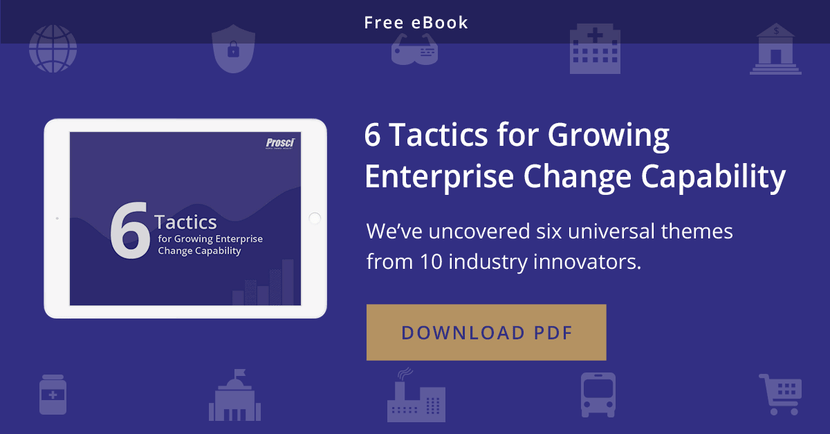

Prosci's Change Management Planning Checklist draws from decades of benchmarking research and forms the foundation of the organizational tools and processes associated with managing change on initiatives and projects.
Prosci's Best Practices in Change Management – 12th Edition research revealed that 69% of respondents adhered to a structured methodology. Additionally, participants cited the use of a structured process and tools as the second most important contributor to success, behind effective sponsorship. Correlation analysis shows that change management efforts using a structured approach are more effective and more likely to achieve project objectives.
A “one-size-fits-all” approach to managing change is ineffective. Change management strategies and plans should be scaled based on two factors:
Be sure that your change management approaches are customized to address the unique attributes of the initiative.
6 Tactics for Growing Enterprise Change Capability
We heard from 10 industry innovators about how they’re building change management into the fabric of the organization.
Successful organizational change can only occur when each individual impacted by the change goes through their own personal transition. The most effective approaches to managing change combine an individual model for how people experience change (such as ADKAR®) with the organizational tools that can be used to support this individual change (communication, sponsorship, coaching, etc.).
Sponsorship—the active and visible participation of the leaders who authorized and funded an initiative—is repeatedly cited as the number one contributor to change success. The level of the primary sponsor must align with the size and type of change and the groups being impacted by the change. Determine if the change has the right level of sponsorship before moving ahead.
Best practices research has identified three key roles of sponsors:
Many times, change agents must coach their senior leaders to fulfill these roles, both making them aware of the roles and supporting the execution of the roles. Find out more about sponsors in the Prosci Sponsorship Checklist.
Effective communication plans are targeted to the audience, use a variety of channels, provide feedback opportunities and capitalize on the preferred senders of change messages. Be sure that the communication plan is not just deciding what you want to tell someone, but architecting a complete approach to ensuring that receivers understand and internalize your key messages. Find out more about communication plans in the Prosci Communications Checklist.
People managers play a crucial role in making organizational changes successful:
A complete change management approach includes a plan for engaging people managers and helping them embrace the change themselves. In addition, this plan provides managers with the tools and support they need to succeed in their role as coaches and resistance managers during the change.
Resistance management is a central component of change management. Proactive resistance management involves identifying what resistance might look like, where it might come from and ways to answer objections and build support early in the project. Reactive resistance management includes ways to effectively deal with resistance when it does emerge during implementation. A good change management approach includes both of these tools.
Ultimately, change management is all about achieving results. Successful change management means that projects meet their objectives and employees adopt the solution. Before the project is implemented, think through how you will know if the project is meeting objectives. As the change is being implemented, measure adoption and gather feedback from employees to understand if they have made their personal change successfully.
The project's success will ultimately be determined by whether or not the change sticks. Be systematic and structured when you develop ways to reinforce the change. Reinforcement does not take place only at the end of a change; implement mechanisms to keep the change in place throughout the project. Without reinforcement mechanisms, employees tend to revert back to the old way of doing things.


Tim Creasey is Prosci’s Chief Innovation Officer and a globally recognized leader in Change Management. Their work forms the basis of the world's largest body of knowledge on managing the people side of change to deliver organizational results.
See all posts from Tim Creasey